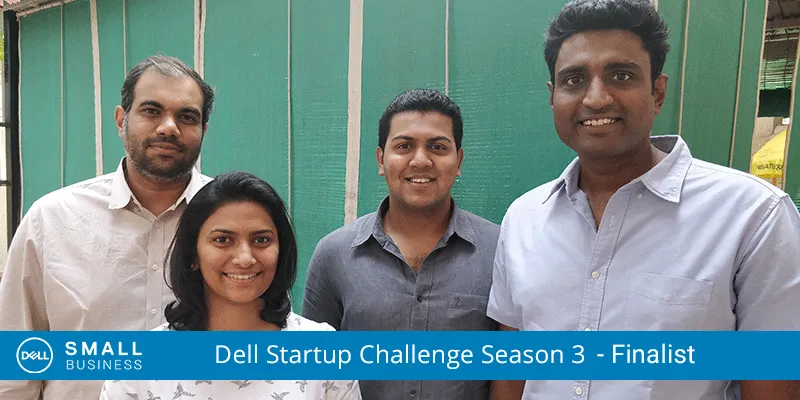
Dell Small Business
View Brand PublisherEyedentify is keeping a watchful eye on drivers to make roads safer through IoT and analytics-based monitoring systems

“Out of 18 million+ road accidents recorded globally, over 80 percent are due to driver-error caused by driver fatigue, drowsiness, distracted driving, use of mobile phones, etc,” says Anirudh Injeti, co-founder of Eyedentify.
These statistics prompted engineering college friends Anirudh, Dhushyanth Dachiraju, Krishna Jasti, and his wife Rajashree to come up with solutions that could prevent such mishaps.
“We felt that the transportation space in India was lacking on many fronts. The sheer magnitude of road accidents caused due to human error and the soaring rate of crimes that take place inside vehicles were a cause for concern. Therefore, driver and passenger safety and fleet management became the specific areas we wanted to focus our energies on,” says Anirudh. So in 2016, they started up Eyedentify, a Hyderabad-based automotive IoT company.
Explaining their solution, he says, “Companies working on driver and passenger safety are predominantly focused on ADAS (Advanced Driver Assistance System). These systems focus more on conditions outside the car (such as sudden lane departures, getting too close to another car and such), and helps avoid collisions with other vehicles, crashing into pedestrians, etc. ADAS systems require proper system integration at the time of designing the car, are usually quite expensive to adopt and, as a result, are typically found only in high-end automobiles.”
Eyedentify, on the other hand, works on DMS (Driver Monitoring Systems) which use cameras to continuously monitor the driver’s face and eyes for signs of drowsiness/fatigue and distracted-driving. Once the system detects these conditions, it will immediately alert the driver so he/she can stay attentive while driving. DMS is cheaper than ADAS and facilitates easier integration with the vehicle. DMS devices can also be integrated as an after-market product in automobiles.
Ensuring that both drivers and passengers are safe
Currently, they have commercialised a live video transmission product, called VOSS Live, which transmits multiple video streams over the internet in real time from cameras placed inside vehicles such as buses. The live video feed, which is also stored on the device for longer durations, along with the vehicles’ location information, are made accessible to the fleet owner through interactive web and mobile applications. The application also gives fleet owners access to generate various informative reports, receive important notifications and keep track of their vehicles and passengers, all of which help in streamlining the operations. The interest for this product is predominantly from educational institutes, which have integrated them with student transport vehicles, and inter-city passenger transport vehicles.
They have two more products focussing on the passenger car space, trucking industry and inter-city passenger transport industry, which are currently in the field-testing phase.
The first is DMAS (Driver Monitoring & Alerting System), a camera-based solution that discreetly monitors the driver’s face and notifies him/her through audio alerts in case it detects that he/she is drowsy, distracted, using a mobile phone, etc. The fleet owner is also notified of such events. “This solution has been designed keeping in mind the staggering number of road accidents that are recorded (and several that are not recorded) due to driver error. We strongly believe that this solution will proactively reduce the odds of an accident occurring in the first place,” says Anirudh.
The second, VOSS AI, is a passenger analytics platform that keeps count of the number of people getting in and out of a bus along with the vehicle’s location information -- all this is without any human intervention. The information is disbursed in a timely manner to fleet owners through web and mobile platforms. This solution aims to help fleet owners tackle the issue of drivers and conductors transporting non-ticketed passengers in inter-city buses.
Making their way in a brave new world
Says Anirudh, “It is safe to assume that the market for AI and video analytics-based products in the transportation space is still new across the globe and companies are working on finding the right product fit to specific use-cases. It is definitely an exciting time to be working in this space because of the possibilities that exist here.”
And their numbers justify this excitement. They’ve shown a significant Y-O-Y growth from FY 17-18 to FY 18-19 of 326 percent. They were bootstrapped until late last year when they raised $100,000 in funding and are currently looking to raise another $500,000 towards the end of 2019.
However, getting here was not without challenges. Initially, getting proper inputs and feedback before commercialising a product was one such challenge. “Our first product had more features than the market was seeking at the time. This resulted in the price being too high. After taking the advice of industry experts and interacting with various fleet owners, we were able to rework the idea and modified our solution to be in line with customer needs as well as within the desirable price range,” says Anirudh.
Nevertheless, their journey continues. “Being a part of the Brinc accelerator programme in Hong Kong, where we interacted and received valuable feedback from the people who are instrumental in running the programme was beneficial. We now have a better understanding as to how we must position our product,” he adds.
They have also recently been chosen as part of a programme that solely focuses on innovation in the mobility space. “The programme is designed and managed by experienced people in the automobile industry and we believe this will help us further refine and improve our product.”
All eyes on the road ahead
So far, their focus has been to sell to customers in the B2B market. Now, they plan to cater to the B2C as well, and have their sights set on becoming an OEM supplier in the future.
The four co-founders, with their varied experience across sectors, play a key role in mobilising the 10-member Eyedentify team towards this future. Anirudh, who heads Operations and Marketing, has an MBA in supply chain management from Institute of Management Technology, Hyderabad. He previously worked with India Cements Limited, Chennai, and BNPMIPL, an RBI-managed currency paper manufacturing firm. Dhushyanth, who drives the company’s IT infrastructure design and product development, has a masters’ degree in computer engineering from the University of Texas, Arlington, and has worked as a software engineer in Goldman Sachs, Tomax Corp (now part of Salesforce) and Bank of America, among others. Krishna pursued a masters’ degree in Electric Vehicle Engineering from Wayne State University, Detroit, and went on to work with IAV Automotive, an electric vehicle consulting firm, and a sister concern of the Volkswagen Group. He heads product conceptualisation and integration at Eyedentify. Rajashree studied finance and accounting from the University of St. Andrews, Scotland, and later worked for Deloitte. She handles Eyedentify’s finance and accounting-related matters.
How Dell Startup Challenge is helping in their journey
Eyedentify was one of the winners of the Dell Startup Challenge, Season 3, in the general category. “Dell is one of the largest companies in the computer technology space. They have quite a formidable supply chain and service network the world over as well. The possibilities of interacting and being guided on the tech and business development front by experienced teams at Dell had us very excited. The fact that we are one of the winners has given us a lot of confidence in what we are building. There is also a sense of validation of the direction in which we are heading. We will continue to focus our energies on building relevant products for the automotive domain and seek guidance of Dell from time to time,” shares Anirudh.







